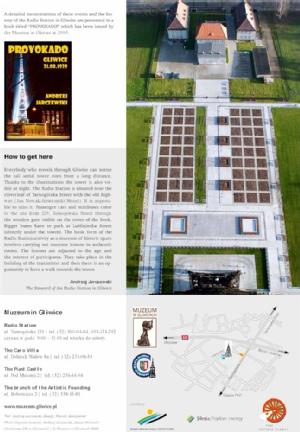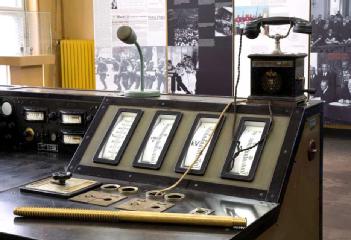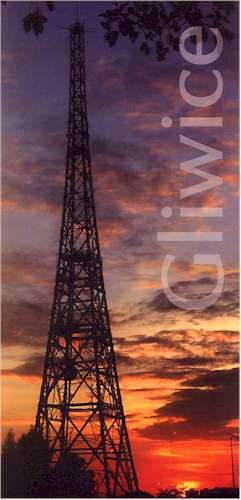
Muzeum Historii Radia i Sztuki Mediów Radiostacja Gliwice (Radiosender Gleiwitz) |
44-100 Gliwice, Poland (śląskie) |
|
| Address |
Tarnogórska 129
|
| Floor area | unfortunately not known yet |
Museum typ
Transmitting and Studio technique
|
Opening times
|
Tuesday - Friday: 10.00-16.0; May - September: Saturday & Sunday: 11.00-16.00
wtorek - piątek: 9.00–16.00; maj – wrzesień: sobota i niedziela: 11.00–16.00
|
||||
|
Status from 08/2016
|
We don't know the fees. | ||||
| Contact |
|
||||
| Homepage |
www.radiostacjagliwicka.republika.pl www.muzeum.gliwice.pl |
||||
Our page for Muzeum Historii Radia i Sztuki Mediów Radiostacja Gliwice (Radiosender Gleiwitz) in Gliwice, Poland, is not yet administrated by a Radiomuseum.org member. Please write to us about your experience with this museum, for corrections of our data or sending photos by using the Contact Form to the Museum Finder.
| Location / Directions |
|
| Description | UNUSUAL TOWEROne of the most characteristic structures in the Upper Silesia is an aerial tower, located at the Tarnogórska Street in Gliwice. The building complex of the radio station was built in 1935 by a German company Lorenz (co-operation: Siemens, Telefunken, and others). In the main building there are many pieces of original equipment preserved, reaching back to the pre-war period. The most precious object of the whole complex is, obviously, the broadcasting tower, allegedly the tallest wooden structure in the world (111 m). Carefully conserved, protected and repaired every year, it still has – according to the scientists from the Silesian University of Technology – many years of safe functioning ahead. The tower is built of larch wood, particularly resistant to pest and atmospheric factors. The beams are combined with brass screws. There is not a single iron nail there.Upon the tower about 50 aerials of various types have been installed, operating for mobile telephones networks, radio-taxi, the CCM radio station, etc. Thanks to rents paid by the users, the tower “makes its own living”. Our tower looks specially attractive in the dark. Illuminated with massive spotlights, it is well visible from a distance of many kilometers, and it makes everlasting impression upon its visitors. WHAT HAPPENED HERE?31st of August, 1939 at 8.00 p.m., the German radio station in Gliwice was broken into by a few SS troops members in civilian clothes, claiming to be Silesian rebels. Their leader was SS-Strurmbannführer Alfred Naujocks, appointed by SS-Gruppenführer Reinhard Heydrich, the chief of the General Reich Security Office, acting on the direct order of Hitler. The operation was top secret. Only the text of the password which Heydrich was to pass to Naujocks on the phone was determined: ”Grossmutter gestorben”. The password constituted an order to commence the operation. The aggressors terrorised the German crew and broadcast a Polish announcement: “Attention! This is Gliwice. The broadcasting station is in the Polish hands...”. The remaining part of the proclamation read out loud in that moment was not emitted due to technical errors.In the radio station Franciszek Honiok, a Polish Silesian, was murdered – at present he is believed to be the first victim of the World War II. On the previous day he was arrested by Gestapo in his home village £ubie near Pyskowice. Honiok, intoxicated with drugs, was brought to the radio station as “a tin” at 8.05 p.m. He was supposed to be the proof of “the Polish guilt”. On the next day Hitler gave a speech where he justified the outbreak of war with border provocations performed allegedly by Poles. Hitler did not mention Gliwice, but all newspapers, radios and telegraphic agencies all over the world did. The truth about the Gliwice provocation was discovered as late as during the Nuremberg case. OVERCOMING STEREOTYPESIn 2002 the local government of Gliwice purchased the premises from TPSA (Polish Telecommunications), which had been the owner of the radio station since 1945. At first it was used to broadcast the programme of the Katowice Radio and to jam Free Europe (up to 1956). Later it was a place where radio transmitters and telecommunication equipment were produced. The structure stayed in professional and responsible hands, therefore it is preserved in such a good condition.The goal of taking the radio station over was not only rendering this attractive historic monument accessible to visitors. In the neighbourhood a European Cooperation Centre will be constructed. The main concept of the Centre is briefly inscribed upon the commemorating plate, unveiled under the radio station tower: Remembering the past, thinking of the future. |
| Description (other) |
Wieża jest dziś unikatem inżynieryjnym w skali światowej. Budulec naszej wieży to drewno modrzewiowe. Belki zostały połączone śrubami mosiężnymi. Jest tych śrub 16.100 i ani jednego gwoździa z żelaza!
Wysokość konstrukcji drewnianej – 111 m, podstawa – 20x20 m, najwyższa platforma: kwadrat o boku 2,53 m. Drabina wiodąca na szczyt ma 365 szczebli. Zbudowana w roku 1935 wieża znajdowała się stale pod fachową opieką, dzięki czemu jej stan techniczny jest bardzo dobry. Po wojnie dźwigała pionową półfalową antenę Radia Katowice oraz (w latach 1950-1956) pracowała jako zagłuszarka Wolnej Europy. Później w głównym budynku produkowano m.in. nadajniki radiowe średniej mocy na fale średnie. Wieżę wykorzystywano do technicznych prób nadawczych, a od kilkunastu lat – głównie do łączności radiotelefonicznej (Centrum Ratownictwa Gliwice, telefony komórkowe, internet bezprzewodowy i in.). Na różnych wysokościach zamontowano ponad 70 różnych anten. Wieża sama zarabia na swoje utrzymanie i konserwację. |
Forum contributions about this museum
Muzeum Historii Radia i Sztuki Mediów Radiostacja Gliwice (Radiosender Gleiwitz)
Threads: 1 | Posts: 1
|
Hits: 7547 Replies: 0
Museum Sender Gleiwitz - Gliwice
|
|
|
Wolfgang Scheida
11.Jan.07 |
1
Ein interessierter RM.org Gastbesucher hat mir eine Infobroschüre zum Sendermuseum Gleiwitz zukommen lassen. Offensichtlich dürfte die Stadt Gliwice im Sinne der Tourismusförderung der Herausgeber sein.
Daraus geht hervor, dass der hölzerne(!) Sendemast im Original erhalten ist sowie auch weitere Vorkriegstechnik zur Besichtigung bereit steht. Ziel ist es eine Art Gedenkstätte aufzubauen. Der interessierte Reisende kann sich unter: www.radiostacjagliwicka.republika.pl informieren.
|
Muzeum Historii Radia i Sztuki Mediów Radiostacja Gliwice (Radiosender Gleiwitz)
End of forum contributions about this museum
End of forum contributions about this museum
Radiomuseum.org presents here one of the many museum pages. We try to bring data for your direct information about all that is relevant. In the list (link above right) you find the complete listing of museums related to "Radio & Co." we have information of. Please help us to be complete and up to date by using the contact form above.
[dsp_museum_detail.cfm]
| Data Compliance | More Information |






